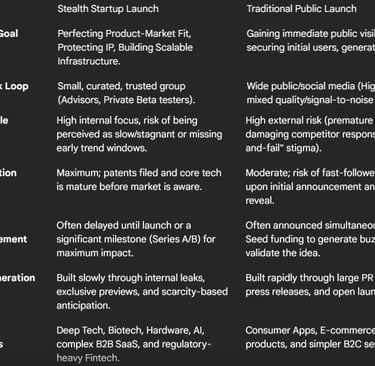The Art of the Undisclosed
The modern business landscape is a relentless echo chamber—a place where ideas are born, announced, and often copied within the same news cycle. In this age of constant noise, fierce competition, and information overload, launching a startup has become more complex than ever. Every idea, every innovation, and every product enters a global race the moment it’s announced. To survive the initial scrutiny and develop true, defensible advantage, founders are increasingly choosing a different, more calculated route: the stealth startup.
STEALTH STARTUP
11/16/20254 min read


Why the Stealth Startup is the Ultimate Strategic Playbook for the Modern Founder
What Is Stealth Startup?
A stealth startup is an entity that makes the operational decision to maintain a minimal or non-existent public profile during its formative stages. It’s an intentional choice to operate in "stealth mode," focusing intensely on proprietary technology development, product refinement, and strategic testing behind closed doors.
This isn't merely delayed marketing; it is a fundamental business strategy rooted in precision and control. The outward silence belies furious internal activity, which includes securing crucial seed and early-stage funding, forging exclusive, high-value partnerships, and meticulously building the infrastructure required for immediate scale. The team acts less like a startup seeking attention and more like an advanced engineering project: every system is optimized, stress-tested, and polished before ignition.
The Strategic Imperatives of Operating in Stealth Mode
1. Protecting Intellectual Property (IP) and Market Position
Innovation attracts imitation. When building something truly disruptive—be it a proprietary AI algorithm, a novel biotech compound, or a unique hardware component—early exposure offers competitors a crucial window to replicate or develop a 'fast-follower' strategy. Operating in stealth allows founders to file critical patents, secure trademarks, test prototypes in private Beta environments, and build a foundational technology stack without revealing their strategy to the wider market. This time buys a critical competitive lead, creating an "IP moat" around the business.
2. Achieving Deep Product-Market Fit (PMF) Before Public Scrutiny
The pressure of public expectation and the inevitable 'tech press' critique can be crippling for a nascent company. When a product is launched too early—a phenomenon often called "vaporware"—it can never recover from a bad first impression. By staying under the radar, teams can iterate rapidly, fail cheaply in private, and collect honest, deep-dive feedback from a small, curated group of advisors, initial B2B partners, and private testers. This ensures the product is validated and truly resonates with the target audience before the noise begins. A public launch then becomes a triumphant declaration of a proven product, not a public test of a shaky prototype.
3. Building Foundational Momentum Behind the Scenes
While the public perceives silence, the stealth company is focused on high-leverage activities:
Funding in the Shadows: VCs are often key participants in the stealth phase, providing capital and strategic guidance without making a public announcement, reserving the fanfare for the eventual product launch. This focus allows founders to concentrate on development, not constant public relations.
Elite Recruitment: Targeted, confidential hiring allows the company to onboard top-tier talent who are drawn to the vision, mission, and the promise of working on something groundbreaking without distraction.
The Mechanics of Stealth: How It Works in Practice
Successfully operating in stealth requires discipline and a specific operational structure that goes beyond simply not having a website:
Controlled Communication: Team members often operate under strict Non-Disclosure Agreements (NDAs). External communication, including social media and LinkedIn profiles, is vague, referring to the company as a generic "early-stage technology company" or "pre-launch venture" based in a specific hub (e.g., "AI-focused venture in San Francisco").
Targeted Beta Programs: Instead of an open beta, stealth companies run closed, private betas with a hand-picked, influential group of users whose feedback is considered gold. This group is often under an NDA, ensuring that any leaks are strategic, not accidental.
The "Pre-Launch" PR Funnel: The company controls the information flow by selectively briefing key industry analysts, journalists, and thought leaders weeks or months before the public announcement. This groundwork ensures that when the launch day arrives, the coverage is immediate, knowledgeable, and universally positive.
Modern Context: The Value Proposition in Today's Digital Ecosystem
In the 2020s, the speed of information transfer has made the protection offered by stealth mode more valuable than ever. Social media and tech news can amplify a half-baked concept overnight. The 'fail fast' mantra should apply to private testing, not public perception.
This approach is especially critical for:
Deep Tech and AI: Where the core IP is a unique algorithm or proprietary dataset that must be protected.
Biotech and Hardware: Where innovation cycles are long, require extensive regulatory approval, and demand significant upfront investment in Research & Development (R&D).
Fintech and Security: Where trust, compliance, and a flawless, bug-free launch are non-negotiable foundations for the business model.
Real-World Triumphs: When Strategic Silence Pays Off
Many globally recognized companies began their journeys in deliberate stealth. These examples demonstrate that stealth mode is a playbook used by the world's most strategically minded founders:
Comparison Table: Stealth Launch vs. Traditional Public Launch
This table highlights the fundamental differences in approach and goals between a stealth startup and a venture that chooses to launch publicly from day one.
The stealth startup is not just a secretive company—it is a strategic framework for the smart, disciplined founder. It allows teams to innovate privately, refine intelligently, and launch with maximum, controlled impact. By keeping their cards close to their chest, stealth founders maintain complete control of their product narrative, protect their intellectual property moat, and create the foundational stability necessary for truly sustainable, long-term growth.
In a world that rewards frantic speed and instant visibility, the stealth startup reminds us that strategic precision and perfect timing are often the ultimate competitive advantage.










© 2025. All rights reserved.
